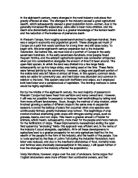Among the time period of 1750 to 1914 in Western Europe and East Asia, women obtained social and economic expectations that would label them with their "normal" practices.
Ada Rivera
Mr. Hamstra
AP World History Pd. 2
May 7th, 2012
Among the time period of 1750 to 1914 in Western Europe and East Asia, women obtained social and economic expectations that would label them with their "normal" practices. Until the French Revolution and the Industrial Revolution, women began to take part in the fight against their labels and for their goal of equality with men. As in both regions, women testified against the rest of their society, there were different routes into how these women obtained their long-awaited-for equal rights. As time progressed, as did the rise of their rights and changes in society for women and their surroundings as they became far more independent and important.
Before the French Revolution in Western Europe, women were being viewed at as biologically and socially different from men, therefore they played the roles of family rather than political, like the men were. But when the French Revolution began to take place, women participated in almost-always controversial events. Women began to take stand with their equality with men, against people like Jean-Jaques Rousseau, for example where he describes his vision of an ideal education for women where they should take an active role in the family, but they should not venture to take part politically outside of their home. Those who favored improving the status of women often insisted on women's right to education, rather than the right to vote. Then, female activist Marie Gouze (under the pen name Olympe de Gouges), attacked slavery in her writing "Declaration of the Rights of Women", based off of the "Declaration of the Rights of Man and Citizen" document. De Gouges states in her document that women has been excluded from their potential roles and although her declaration did not stimulate a large support system, it did make her notorious but eventually came at stake with persecution with the government. Women never gained full political rights during the French Revolution as the national assemblies did not consider legislation with granting political rights towards women, where they could neither vote nor hold office. Women did not stop and yet continued to participate in various forms with riots over prices of food, some joined clubs organized by women, and other took parts in movements against the Revolution, such as taking part in the massive rebellion in west France against the revolutionary government. Upper class women were expected to be married into money and have an education; their higher class was not expected of them to run households, as they had been in past centuries. The middle class women were expected to run households, stayed home until they were married , and often became writers as there were not many occupations offered to their class. The working class women would work for a living while single and were expected to keep on working until married, in such places like domestic service but were not equal to men's jobs at the time. For the mid 19th century, more forms of employment became available to women and girl's education began to be taken more seriously. There were more schools for girls offering an academic education with boys and with the expansion of education, it offered more job opportunities for teachers. Technological inventions also lead to occupation expansion, as the invention of the typewriter supported to a larger range of jobs for women in offices. In the early 20th century, some women became active in the women's suffrage movement, testifying for votes from the women. Western European rights an women progressed with their equality as time progressed.







